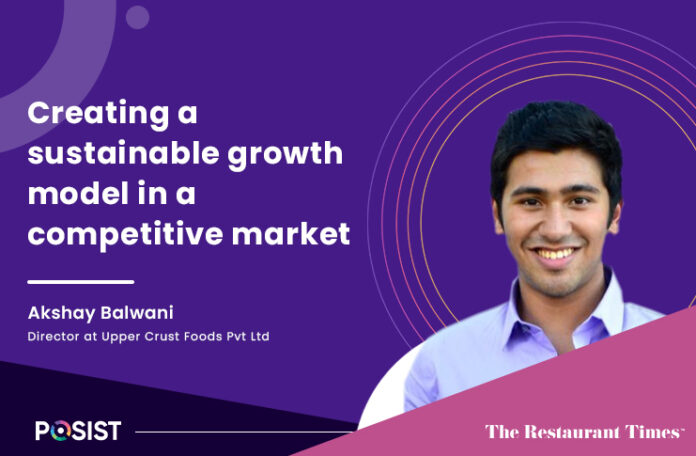Akshay Balwani is an experienced F&B entrepreneur. He is a Director at Upper Crust Foods Pvt. Ltd, the master franchisee of Sbarro – New York Pizza in India. After having worked in the publishing, and technology industry, Balwani’s passion for food led him to join his mother, and MD, Rashmi Balwani. After identifying a huge potential for high-quality pizzas in the value segment, he decided to handle the reins of the master franchisee of Sbarro LLC in India.
As a pizza brand, Sbarro is known to deliver authentic New York-style pizza. Pizza, as a category, enjoys great popularity in the country. There are several international and national players competing with each other. Sbarro, in the middle of all this, has been able to create a unique foothold in the market and has a strong presence of its own.
In Conversation with Akshay Balwani of Sbarro India
In an exclusive conversation with The Restaurant Times, Akshay Balwani shares insights from his entrepreneurial journey about how to sustain and grow in a competitive market, and the role of localization, operations, and technology in creating a sustainable business model.
TRT – Since Sbarro first entered the Indian market in 2012, it has been able to expand to more than 30 outlets. What has been your expansion strategy and what are the best and most effective ways to sustain and grow in this industry?
Akshay – For the first 5 years, our Managing Director, Rashmi Balwani, who is also my mother, took up the brand conceptualization and set up the whole structure for the business. As a company, we realized early on that we do not want to be one of those brands that open and close in quick succession. There are multiple reasons for this; it could be the wrong choice of partners, location, the mismatch between the brand and what the customer wants, and misalignment of the offerings with the branding. Therefore, we decided to take it slow and focused on keeping the brand aligned with what we offer.
Sbarro offers a premium product at a value pricing and we wanted to play in this niche. Globally, Sbarro has done well in malls, entertainment hubs, convenience centers, and transit hubs like airports, railways, and highways. Any kind of place which has a captive audience has worked well for Sbarro and in the Indian market as well, we latched onto that and built our way forward.
Our food court model has worked well for us. We have a presence across all A and B categories of malls in Mumbai city. In Pune and Ahmedabad, we have also built a delivery model keeping in mind the local tastes and preferences. We have taken the global product, and have tailored it for the local market. Our high street presence works well to meet the demand for delivery in India.
Our approach has been to make the model work and then expand, instead of expanding and then hoping it works. This is one of the reasons why you won’t see sudden outlet launches and closures with Sbarro like with so many other brands. We are not a brand that would open 8 outlets in a year and then suddenly close them all down in the next year.
TRT – Sbarro India provides a quality pizza experience to the Indian masses at a value price so we would like to understand your thoughts on formulating an effective pricing strategy. Also, how do you balance the cost of product versus pricing? Keeping in mind the inflation rates are constantly increasing and raw materials are getting more expensive.
Akshay – Yes, that’s a constant challenge. Quite honestly, I don’t think that anybody has mastered it, especially in the value segment.
Maybe the bigger volume players like Domino’s, and McDonald’s, have a huge volume required to lower their cost enough that the cost of the product gets affordable after a certain threshold. The margins are proof in the mid-segment (30-50 outlets brands) that it gets hard to balance pricing vs cost because we have the cost structure of a big company with a big footprint. But then, we don’t have enough volume to achieve economies of scale.
But what we have always tried to do is benchmark what we want as our target in terms of food costing and play with discounting, product mix, menus, values, and combos to hit that target with some variance, accounting for inflation and other changes.
That said, apart from the random shocks that we sometimes get like, last year with a random increase in all the prices. With the pandemic, there was a massive increase in cheese prices. When these big shocks happen it’s out of your control and all you can do is tighten your belt and hold on until it waves off.
Other than this, we have tried to benchmark and maintain. We can’t increase the prices indefinitely so we have to play with our premium products. We have to closely monitor our value products. We check the pricing available on third-party applications, and the pricing that we offer, and then we have to find a middle ground where we hit that benchmark.
Akshay – The right person to answer this question would probably be my mother because she had some massive challenges while the brand was being set up in India because it’s an international brand. These kinds of brands come with their own set of challenges and then you have to adapt them to the Indian market. That’s the delicate part she had to navigate. She figured how much of the menu needed to be Indianized and how much of it is to be kept traditional.
I think balance is the key in every segment of the product category. We need to have some Indianisation and some globalization. But it shouldn’t happen at the cost of brand identity as it’s something the brand is known for. There are these constructs that we are known for so we kept the traditional, supreme, signature product intact and added a whole range of Indian localized products.
Again, India is too large a country to say that one kind of localization works everywhere. That is to say, if we are in Ahmedabad we have to localize for their market. In Mumbai, we have to localize for the Mumbai market. I think it is a matter of understanding your brand identity. That said, everything can be local. But if you are a brand that is bringing the authentic New York experience, you can’t localize everything because then you have lost what your brand stands for and what’s unique about you.
Around 40 percent of our menu remains traditional and 60 percent of it is localized. The localization doesn’t always mean adding Indian flavors but localizing to Indian tastes and preferences. We do a barbeque pizza but it has a tinge of spice and sweetness that Indians like. We do a Mexicana pizza but again it would have that tinge of salsa and spice that Indians would like. So it’s not that l am putting everything Indian flavored but it’s about making the product to what the Indian customer would prefer.
TRT – Pizza is a tough category to be in the Indian market and there is stiff competition between the national and international brands. What has been your experience of sustaining in this kind of market?
Akshay – The pizza market is too large. Globally, it is said that the burger market is the largest whereas the pizza market is the second largest. I don’t know whether it is true for India. In India, I think the pizza market might be the largest and the burger market might be the second-largest because there are so many players. There are market leaders and then there are many local players.
So the key factor in our growth has been staying true to our niche. If you are just like everybody else, then there is nothing that will make you last in the long term. In the short term, you might be able to attract the audience by launching a whole bunch of offers and other things that could work for the shorter term. However, if you want to make it work in the long term, then you have to find a niche.
There are three fundamentals to our pizza and we don’t change that. The first is the hand-stretched dough. The second is the San Marzano-style tomato sauce. Third, the 100% whole-milk Mozzarella cheese. No matter what the price is we will not waver away from our fundamentals. Once we have this right, everything else depends on our learnings from the market and the competition.
We have to learn from the big players like Domino’s and Pizza Hut but also learn from the local players. Each geography within Mumbai has its favorites. For example, Malad, Bandra, and Andheri, each of these suburbs have its local favorite. So, you have to learn from your local and large players and find what’s working. While you’re at it, you also have to keep your original identity intact.
So for us, it has been important to keep the core constant and not change it. Then, we play with the value element and the flavors. When you have a Sbarro pizza, the toppings are not the only element that delivers taste. We try to ensure that with every bite along the way as you eat your slice, you will find the flavor that you paid for. So, no matter if it’s a barbeque, makhani, kadhai, supreme, or pepperoni pizza, there is enough product in every bite to deliver that flavor combination. At Sbarro, we say that if you finish your pizza till the edge and don’t leave it, then you are eating a Sbarro pizza. But if you don’t, then you’re probably eating one of our competitor’s pizzas.
TRT – What kind of role do you think technology has played in optimizing the operations and growth for Sbarro?
Akshay – It has made a world of difference. In the last 10 years, that we have been in the market we have seen technology evolving. The legacy POS software for the enterprise was based on a server and SQL. It would have no internet connection and would sync once a day. With no live data available, you have to depend on your staff to send you data. There was no aggregator around a decade ago. At that time, the delivery could not be tracked. Inventory reports used to come laggard. It was a whole different world. However, in the last 6- 7 years, the world has changed.
For a large part, with the advent of the cloud, data has become accessible to us. Our POS is integrated with the delivery aggregators and we get the data live about our orders. We use the cockpit app from Posist. All my managers and I use the app. No matter where I am in the world, I can easily check data through the app. I don’t have to call anybody to get any information. I think this is where all the technology comes in. You can get real-time data, updates on your stock and purchase, and check how much stock is left in your inventory at each store.
I think it’s also about being able to give the customer a better experience. The customer can see when their order will reach them. They can get information about the driver assigned and can call the driver or the restaurant. All of this is possible because of technology. And I think we are moving in the right direction where the restaurant industry knows more about its own business now than what we did around 6-7 years ago.
TRT – What is your vision going ahead? What advice would you like to give all the budding restaurateurs?
Akshay – There is not a straight path to where you want to get. COVID showed us this. I strongly believe that you can set a goal but how you get there will constantly keep changing. For example, our goal is to have to go from a single-city presence in India to a multi-city presence. And, how we get there is going to depend on the city and who the customer is. So, we might go to the mall, the high street, and the cloud kitchen. We don’t know a few answers yet and I think that is part of the journey, but what we do know is that we want to keep executing well on our product. And, this is the fundamental advice I would give myself.
I don’t want to give anybody any other advice. I always tell myself that if you keep executing well on your product and your operations are top-notch, marketing and competition from other brands may give you a small dip once in a while. But it won’t let you die. It would ensure consistent organic growth for you. If you keep executing well, you have a good product.
That said, don’t just have a good product but also evolve and develop new products and keep executing them well. I think for me, operations is key and I don’t think you can win a war with just marketing or just by building a brand by putting hoardings. We have seen ample large brands falling because of poor focus on operations.
Each brand knows what they want to do and I don’t want to say anything but keep executing well and keep growing. That’s my motto.

















